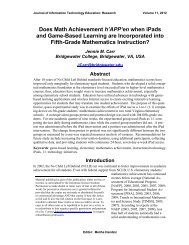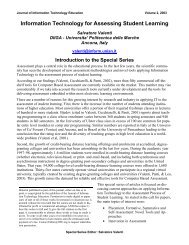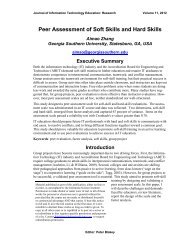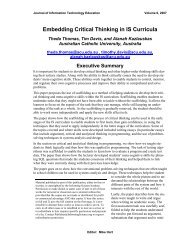Collaborative Learning in Online Study Groups - Journal of ...
Collaborative Learning in Online Study Groups - Journal of ...
Collaborative Learning in Online Study Groups - Journal of ...
Create successful ePaper yourself
Turn your PDF publications into a flip-book with our unique Google optimized e-Paper software.
<strong>Collaborative</strong> <strong>Learn<strong>in</strong>g</strong> <strong>in</strong> Onl<strong>in</strong>e <strong>Study</strong> <strong>Groups</strong>: An EGT Perspective<br />
<strong>in</strong>dividual members <strong>of</strong> a learn<strong>in</strong>g community <strong>in</strong> higher-order th<strong>in</strong>k<strong>in</strong>g activities such as problem<br />
solv<strong>in</strong>g and critical th<strong>in</strong>k<strong>in</strong>g.<br />
Collaboration <strong>in</strong> small groups has been particularly recognised as both advantageous and appreciated<br />
by students. It has been shown that small groups enable students to identify and correct misconceptions<br />
more easily and quickly and to improve understand<strong>in</strong>g <strong>of</strong> the topics be<strong>in</strong>g studied<br />
(Gayatan & McEwen, 2007). In addition, small groups are considered as more suitable for group<br />
discussions and equal contribution <strong>of</strong> group members (F<strong>in</strong>egold & Cooke, 2006). Spr<strong>in</strong>ger,<br />
Stanne, and Donovan (2009) found that small groups provide students with a better learn<strong>in</strong>g experience<br />
and ultimately greater academic achievement, whereas Br<strong>in</strong>dley et al. (2009) reported<br />
that students <strong>of</strong>ten prefer work<strong>in</strong>g <strong>in</strong> small teams over large study groups.<br />
S<strong>in</strong>ce one <strong>of</strong> the primary objectives <strong>of</strong> any educational <strong>in</strong>stitution is to enable its students to acquire<br />
knowledge and skills required for their future pr<strong>of</strong>essional positions, it is <strong>of</strong> utmost importance<br />
for these <strong>in</strong>stitutions to synchronise their curricula and <strong>in</strong>structional approaches with trends<br />
and practices <strong>in</strong> workplace sett<strong>in</strong>gs. Considered from the educational perspective, the major current<br />
trend <strong>in</strong> the workplace is an <strong>in</strong>creased emphasis on the role <strong>of</strong> learn<strong>in</strong>g, where cont<strong>in</strong>uous<br />
learn<strong>in</strong>g and knowledge build<strong>in</strong>g are considered as one <strong>of</strong> the ma<strong>in</strong> responsibilities <strong>of</strong> any <strong>in</strong>dividual<br />
with<strong>in</strong> an organisation (Meister & Willyerd, 2010). Furthermore, the nature <strong>of</strong> work with<strong>in</strong><br />
organisations is chang<strong>in</strong>g from <strong>in</strong>dividual assignments to team-based activities and group work is<br />
becom<strong>in</strong>g common <strong>in</strong> a variety <strong>of</strong> pr<strong>of</strong>essions, especially <strong>in</strong> discipl<strong>in</strong>es oriented towards design<br />
and development. In addition, as the work is becom<strong>in</strong>g more and more geographically distributed,<br />
onl<strong>in</strong>e collaboration among team members has become a regular practice. It has been shown that<br />
skills ga<strong>in</strong>ed from the experience <strong>of</strong> collaborative learn<strong>in</strong>g are highly transferable to team-based<br />
work environments (Shaw, 2006). Accord<strong>in</strong>gly, group work <strong>in</strong> university courses can be considered<br />
as an important preparation for future pr<strong>of</strong>essional life (Smith et al., 2011).<br />
Despite all the above mentioned advantages <strong>of</strong> collaborative learn<strong>in</strong>g, when collaboration is tak<strong>in</strong>g<br />
place <strong>in</strong> onl<strong>in</strong>e learn<strong>in</strong>g sett<strong>in</strong>gs students are <strong>of</strong>ten reluctant to participate actively. The ma<strong>in</strong><br />
reasons for this reluctance <strong>in</strong>clude (but are not restricted to) the follow<strong>in</strong>g (Br<strong>in</strong>dley et al., 2009;<br />
Piezon & Ferree, 2008; Wright & Lawson, 2005):<br />
i. a sense <strong>of</strong> not hav<strong>in</strong>g full control over the quality <strong>of</strong> the group work and the subsequently<br />
assigned grade;<br />
ii.<br />
iii.<br />
concerns that there might be a group member with less than satisfactory performance for<br />
whom other members will have to compensate;<br />
time required for effective collaboration – group work requires students to stick to a particular<br />
schedule, thus reduc<strong>in</strong>g the flexibility and convenience <strong>of</strong> onl<strong>in</strong>e learn<strong>in</strong>g.<br />
In addition, it has been found that many students did not have a chance to experience collaborative<br />
work dur<strong>in</strong>g their previous education and tend to perceive their colleagues as rivals (Sanders,<br />
2008).<br />
The observed difficulties <strong>of</strong> onl<strong>in</strong>e group work are <strong>of</strong>ten a consequence <strong>of</strong> sub-optimal group<br />
formation. In fact, the creation <strong>of</strong> an optimal study group is a challeng<strong>in</strong>g task. Onl<strong>in</strong>e students<br />
typically do not know each other prior to the course they are tak<strong>in</strong>g together and, due to the nature<br />
<strong>of</strong> the onl<strong>in</strong>e learn<strong>in</strong>g environment, the socialisation process tends to last far longer than <strong>in</strong><br />
traditional face-to-face learn<strong>in</strong>g sett<strong>in</strong>gs. Therefore, even when students are given the option to<br />
form study groups on their own, it is difficult for them to do so. Instructors, on the other hand,<br />
<strong>of</strong>ten either have no knowledge about the onl<strong>in</strong>e students enrolled <strong>in</strong> the courses they teach or are<br />
limited to <strong>in</strong>formation about the students’ grades <strong>in</strong> the previous courses. That is far from enough<br />
knowledge for form<strong>in</strong>g optimal learn<strong>in</strong>g groups s<strong>in</strong>ce students differ <strong>in</strong> their personalities, learn-<br />
82










